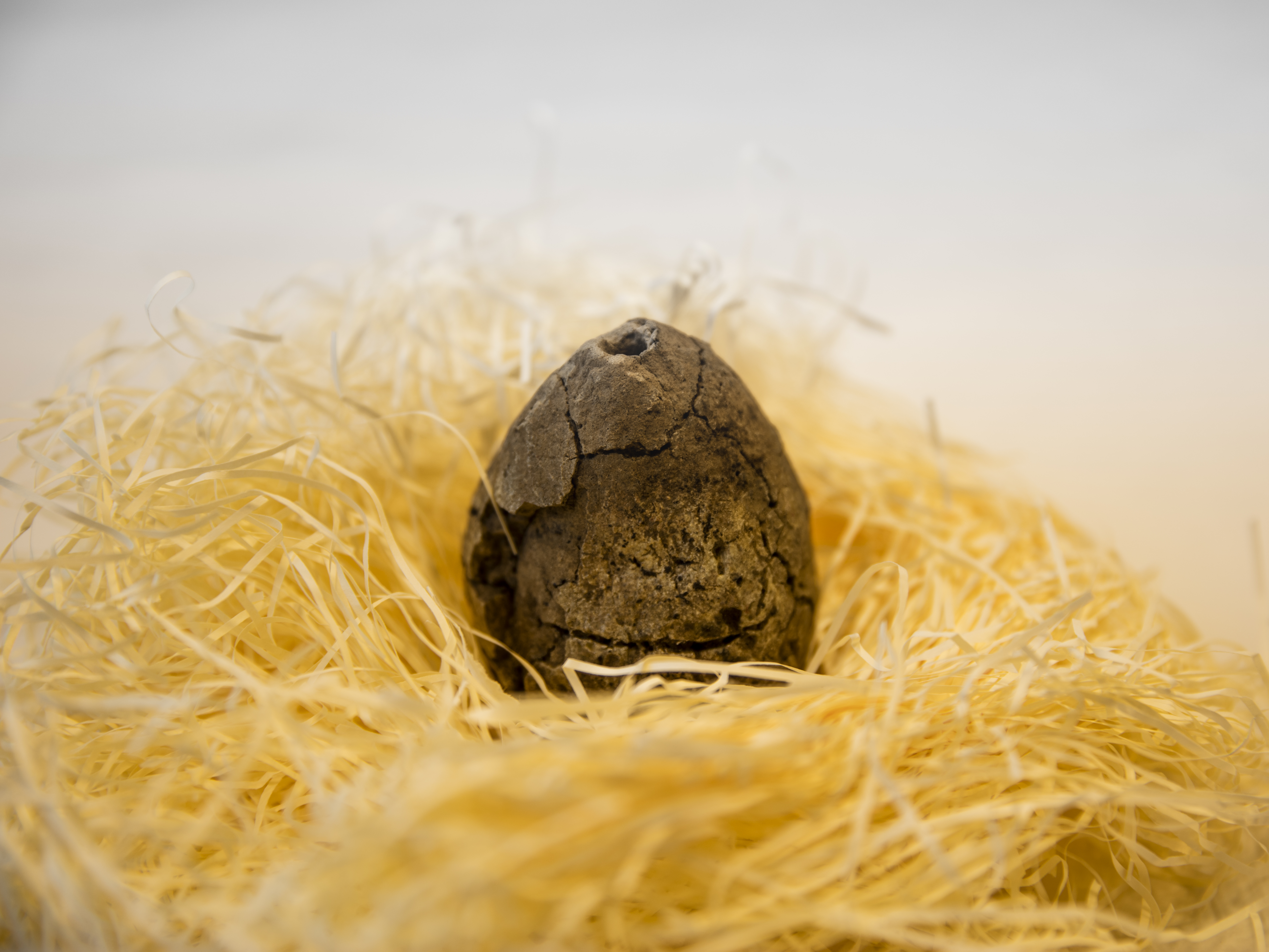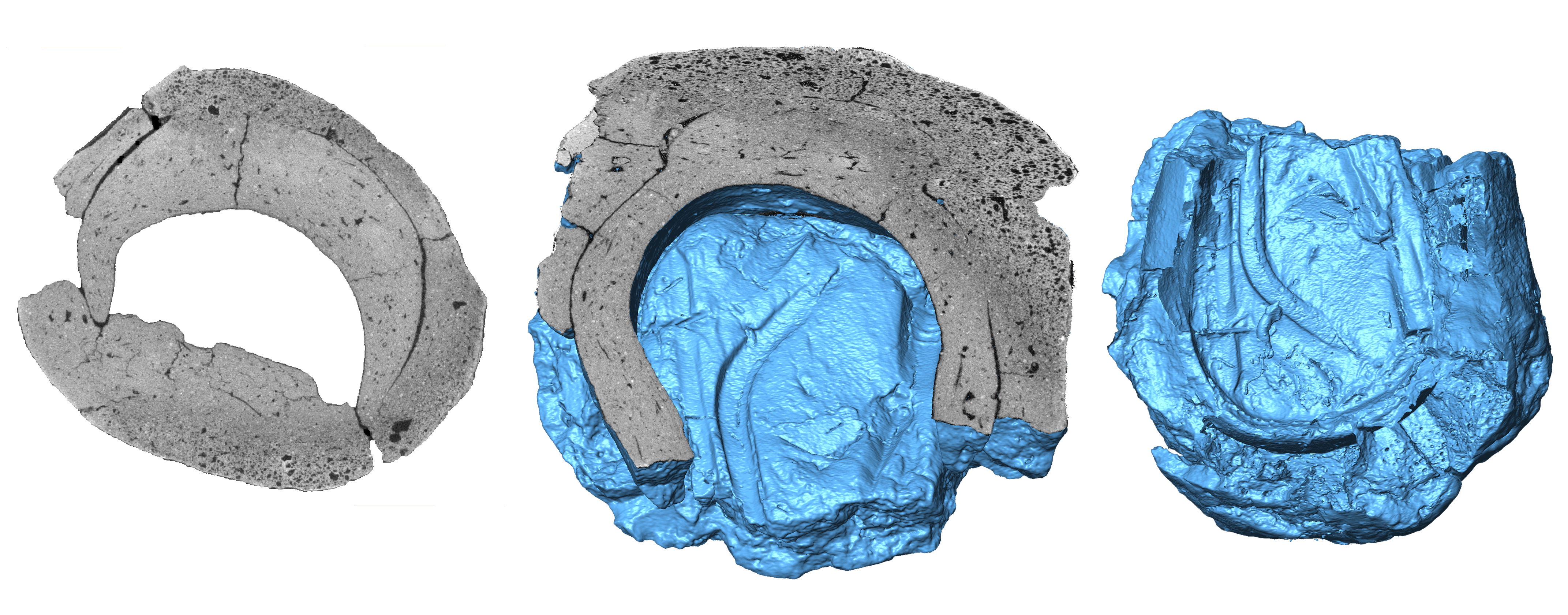In 2016 archaeologists digging at a building site in Tilburg stumbled upon thirteen egg-shaped objects. Geoscientist Dominique Ngan put them in the micro-CT scanner of the Geoscience and Engineering Lab, studied the resulting 3D pictures and noticed some very interesting imprints in their shells. ‘A small find like this can shed a lot of light on a period we don’t know very much about.’
Melting pots from the Middle Iron Age
After an initial investigation and a chemical analysis of the shells by the Cultural Heritage Agency in Amersfoort archaeologists found the eggs were in fact melting pots dating from the Middle Iron Age (some 450 BC). Used to melt down metal objects they had been moulded around the scrap. After heating the molten metal – a copper alloy – was poured out through a small hole at the tip of the melting pot.
A number of the broken melting pots showed imprints on the inside. These imprints were made by the metal scrap, when the scrap was tightly wrapped inside the soil mixture used to form the melting pot. What the exact nature of these objects was and whether the melting pots that had remained intact had similar imprints, the archaeologists had no way of knowing.
Micro CT-scan
To find out they asked Dominique Ngan-Tillard to help them out. In her work as a geoscientist Ngan-Tillard frequently uses a micro-CT scanner to analyse rocks. ‘It is the same as the CT-scanners used in hospitals, only smaller. An object is x rayed producing a 3D model of the inner structure of the object.’
Ngan-Tillard admits she had some doubts to start with. ‘I saw some low-resolution photographs of the melting pots and I thought they were fossils. A nice find, but perhaps not something a scan could shed much light on. But then I saw the imprints in the broken shells and that made me very curious as to what was hidden inside the other objects.’
Scan analysis
After colleagues Wim Verwaal and Ellen Meijvogel scanned the melting pots one by one Ngan-Tillard could start the job of analysing the 3D images on her computer. In the 3D image the various materials and gas bubbles have different colours. ‘Materials dampen X-ray more or less depending on their density and the atomic number of the chemical elements they are made of. Since air does not dampen X-ray, the surface of the cavities could be reconstructed and the traces left by the melted objects could be visualized in 3D. And all this without breaking any of them!’ What Ngan saw were forms with different folding patterns. ‘The archaeologists think these imprints were made by fibulae, or pins used to fasten clothes, and patches to repair kettles or buckets.’
The find is all the more remarkable because it dates from a period about which little is known. ‘Almost all iron objects from the Middle Iron Age were lost or have disappeared because of corrosion. But with these imprints we can tell what the objects were like. It also proves that people recycled metal even then.’
Accomplished chemists
Apart from providing information about the objects they once held the egg shells also tell us something about the level of sophistication of Middle Iron Age society. Using an electron microscope the chemical analysts of the Cultural Heritage Agency established that apart from sand and clay the shells also contained ash from marsh plants, a material rich in sodium. ‘The presence of sodium means the minerals in the clay shell melt at a lower temperature than they normally would so the shell doesn’t crack. Very clever. The people who made these pots were accomplished chemists.’
Life on the surface
The study of archaeological objects such as these melting pots has given her work as a geoscientist a new dimension, Ngan-Tillard says. ‘Normally I look at processes that have taken place in the soil or in rocks but objects tell us something about life on the surface. I’m very interested in history and it’s really special that something so small can provide so much information about how people handled the materials at their disposal and what recycling techniques they used. I was surprised that people were already recycling metal objects 2500 years ago!
3D-printing
The melting pots can be returned to rightful owner Noord-Brabant, copies of the eggs can be made using a 3D printer. ‘A number of the imprints have not yet been identified. We want to make physical replicas based on the digital replicas of the imprints. That will perhaps help Iron Age specialists to identify more objects. Eventually this find will enable us to reproduce complete objects from the Middle Iron Age and show them to the public.’
Published: March 2018




